
|

|
Rancho Camargo
The Deer Dancer
project support
from the
Rockefeller Foundation
Interview with Pamfilo Lopez Ozuna
Rancho Camargo, Sonora (4/1/02)
DB: Where and when were you born?
I was born in a clinic in Navojoa in 1980 on the 14th of October. My parents lived in Los Nachuquis, and we still live there.
DB: How long have you been dancing as the deer?
I began dancing 6 years ago at fiestas and events in our communities. I was 15 then, and I'm still doing it. I enjoy it a lot.
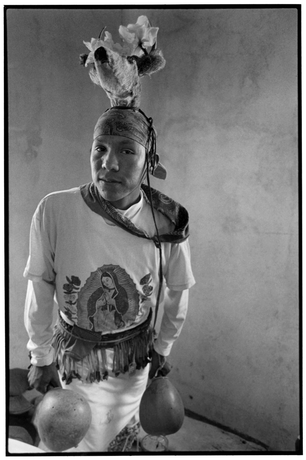
|
|
Rancho Camargo, Sonora 4/1/02 Pamfilo Lopez Ozuna, the deer dancer. |
DB: Your father was also a deer, wasn't he?
Yes, my father danced for 27 years. When I started to dance, he stopped dancing to be with me.
DB: Can you tell me how you began dancing?
When I started I didn't know how to dance. I'd never even been to a fiesta to see it. But suddenly I told my dad, "You know what, I want to dance." He said, "Well get the sonajas. [Sonajas are the ankle and wrist bands made of nuts, that make the sound when a dancer is dancing.] Put the deer on your head and start dancing, so I can see you how you do it and send you." I told him, "You know what, I'm not going to dance for you. If you want to send me, you'll send me. If you don't, then I'll never dance." That's what I told him. So he said, "That's fine. When I get the fiestas scheduled, I'll send you."
And he did. He sent me on December 12th, 1995. He said, "You know what, you're going to go dance at Santa Maria Baraje. That's when you'll figure out how to do it." That's how I started. I didn't know how to do it beforehand. Nobody told me anything, nobody scolded me. Nobody said, "You did this wrong or that wrong." For me it was good. I do it all the same way now as I did when I started. I dance.
DB: Did your father go to this first fiesta with you?
No, my father didn't go with me. According to him he sent a friend so that he could tell me how to do it - let me know what I was going to have to do. But it turned out that I didn't need him. I did everything that I was supposed to do and he never said anything to me.
DB: How did you know how to put on the deer costume?
I never saw my father dress, but before I started dancing, I saw it in my dreams. I saw a large field in my hometown, and I dreamed about a fawn there jumping and jumping. Then a large serpent attacked me. The fawn told me what to do. At first the little animal was in shock, and then he took me jumping. With his little head he told me to follow him. So I followed him to where his parents were — a female deer and a male deer.
I had no idea that I was going to dance, but I kept dreaming this. I wanted to return and he called out to me even more. When I got to this place, I would touch all the little animals. My father says that's where I picked everything up without him telling me. Then I started to dream about the fiesta and what it would be like. That's how I learned to dress myself.
DB: Does your father help you or encourage you now?
It was just the first party, when I danced without him being there. Now, thank God he's with me. He helps me with the anhueja [a drum made from a gourd, the sits in a tub of water while it's being played] and with the group of musicians that I lead. At the same time, he watches me when I don't know what to do, or when he doesn't know what to do. We take care of each other, mutually. When someone is harming him, or knows more than he does, then I help him. Or if he knows more than someone who's harming me, then he helps me. That's how we help each other.
DB: He shares his experiences with you and at the same time you give him advice?
I feel comfortable because he helps me. At the same time, he's old, and I'm new and young. What he couldn't learn, I have been able to learn, thank God, and have helped him. We feel comfortable sharing what we know or what we see at the fiestas.
DB: Why do you dance?
Because I like it. I like it without knowing why or how. I wanted to dance before I went to the fiestas, without knowing what it was like, or about the jealously among the dancers and musicians. Like they say, wanting to dance was born within me.
When I am dancing I thank the saint that I'm dancing for - whether it's Christ, San Juan, Santa Maria, San Jose, or any other. I gladly dance. When the fiesta starts, I focus on the saint and give thanks for being able to learn, for knowing what I know.
DB: You started new things with the deer dance, didn't you?
Yes, after I began to know a lot about the dance, I started to see different things. At first, you don't know the elements that exist in it. But then the dance becomes like a habit you're used to. Now I see many different possibilities, and at the same time I have fun. When I dance, I sometimes get lost. I don't even know what I'm doing. Other people tell me, "You know what you did this, and that other thing." But at the time I'm lost. Because when I dance, I dance.
DB: Have you seen other deer dancers?
Yes, I have. In the town where I live there are two more dancers. Many people tell me, "You leave them at the bottom." When they dance, they don't get a crowd. When I dance, I fill the place. Many people tell me that I do it differently from other people. I don't even dance like my dad. They ask me who taught me, and I tell them that I taught myself. Thank God that what I know, no one has taught me. I see alone, I learn by imitating the things that are in the world. What I know is what I made up, not what others taught me.
DB: Are you doing things to develop your dancing style?
Yes. All the time. You have to look for different things to distinguish yourself from other dancers. They can be new things, or thing from the ancestors that people are now learning again. I look forward and backwards.
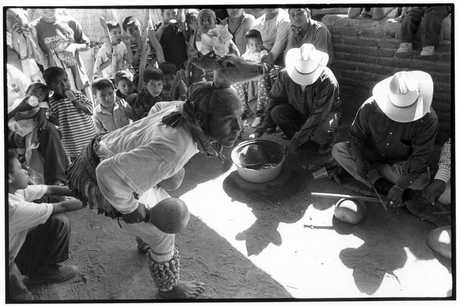
|
|
Rancho Camargo, Sonora 4/1/02 Pamfilo Lopez Ozuna, the deer dancer. |
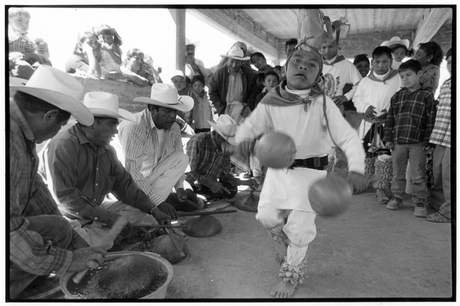
|
|
Rancho Camargo, Sonora 4/1/02 Edgar Ivan Biutihua, a young boy learning to dance the deer. |
DB: When you're looking for the past, who do you talk to get ideas about what they did?
Well logically, to look for stuff in the past, you have to ask the older people, like my father or others that know how they did things before. The new things are ones I don't look for. They are the things that I see along the way and that I do.
DB: Where do the new ideas come from? During your dance you open a bottle, something that other dancers didn't do until you started doing it.
When I started I was dancing no one had ever put out a bottle for anyone. But while I was dancing in one fiesta, a man approached me. He said, "You're from my home town, and I want you to show my friend here that in my town we know how to do things." I never imagined that he was going to put a bottle out there where I was dancing, but he did. He put a beer bottle out there. It took me two hours of dancing without knowing what to do with that bottle. My head was spinning and spinning, thinking of the way that I was going to do it. Until I had it. So I said, "I'm going to open it with my mouth, and if I can't, then too bad." I focused and I opened it, and I felt an overwhelming feeling of satisfaction. I felt good to have been able to accomplish something that others have never been able to do.
DB: What have you found from the past that is part of your dance?
Before, they used to just dance to the drums, play the harp, and the anhueja. Now I get on top of the bule [the big maraca] or on top of the anhueja [the drum played in the water]. This is something that was done by my ancestors, but then people stopped for a long time until I began again. It's not easy, and I'm still the only one doing it. It's not only that you have to balance, but it's very easy to break the gourd.
That's how it's been. Doing what can be done and what can't, too bad.
DB: Did you get the opportunity to go to high school?
Yes. I finished high school, but I didn't go to college or SEBETIS [one of the three teaching colleges in Navojoa, where the schools maintain student dance troupes doing indigenous Mayo dances]. I went to take the exams and I did well, but there was no money. That's where it ended. My father said, "I have no money to give you." I told him, "I'm going to work this year and start the following year." But once you start earning money, you get used to having it and spending it.
DB: So you started to work before you danced?
Yes. I started working even before I started high school. During that time people in my family got sick and my parents went to help them and left me alone. In order to finish high school, I polished shoes, earning money to buy my uniform, books, notebooks, and pens. After high school, I couldn't find any good jobs, so I started working in the fields. Then I started to dance. One week, I'd work in the fields. Then the next there wasn't any work, so I danced. That's how it went. I never really liked working in the fields. I suffered when I was in high school, but now, I don't so much.
DB: Do you have a family of your own now?
Yes, I'm married and have a 7-month baby. I got married here in Rancho Camargo. I didn't get married through the church. We say, "I got married by the "Law of the Mountain." That's what they say when one steals a girl — marries her without her family's permission. I had a civil marriage later, when the baby was going to be born. I have a boy, and I like him a lot.
DB: Do you think that perhaps he too will be a dancer?
Well, when he hears sounds, like at a fiesta, he looks alert, and starts moving and dances. But who knows if he'll like it in the future? Only he will be able to decide what he wants to do.
DB: At the fiesta here there was a young boy dancing.
I think he's around 6 or 7 years old. I don't know for sure, but I do know that he dances very well. He has the desire to dance, to learn. But I don't know if he will dedicate his time to dance or to studying. He's the only one who knows.
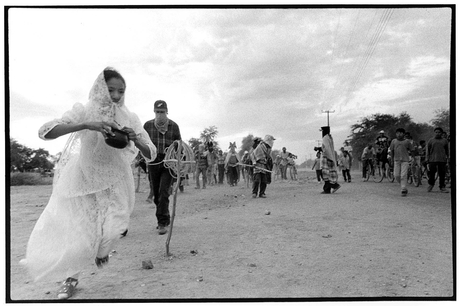
|
|
Rancho Camargo, Sonora 3/30/02 Diana Gabriela Valenzuela Gocobachi, one of the two Veronicas, runs to have water ready for el viejito, as he makes his perigrinacion through the stations of the cross in the streets of Rancho Camargo. |
DB: He has to choose between the two? He can't do both?
Well, he could do both. He's only going to study or dance for as long as he wants. No one can obligate him, or tell him, "you have to dance" or "you have to study." No. Only he can judge how far he's going to take either one.
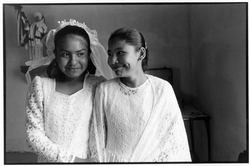
|
|
Rancho Camargo, Sonora 3/30/02 Diana Gabriela Valenzuela Gocobachi and Judith Ofelia Vega Escalante, the two Veronicas. |
DB: What are the challenges of being a dancer?
Being a dancer and studying to have a career are very similar. With dancing you have to learn just the same as with anything else. There's jealously among dancers, and when you follow a career there's jealously there too. You have to know how to take care of yourself and how to move forward. In dancing, you can also teach, just like you can in other kinds of work. In some ways dancing is different, but it depends on how you look at it. In many ways dancing and studying to have some other career are the same thing.
With dancing there's no Social Security [Mexico's national health care program] the way there is with other kinds of work. Teachers, give thanks to God, have Social Security, and can go and get treated if they're sick. With dancing, there is none. If you get sick, you learn how to treat yourself, how to take care of yourself and how to treat others. You learn and don't forget these things. If you want to heal then you will heal.
DB: How do you feel when you're dancing?
When I'm dancing I think about everything. I imagine things. I think about the saint I'm dancing to because you'll never make people happy. The saint you're dancing to will be happy. I think about him and focus on him when I dance. I pray that nothing bad will happen to me or that nothing will fail. I focus, and thank God, I'm here today. Maybe I won't be here tomorrow, but if I'm not, too bad.

|
|
Rancho Camargo, Sonora 4/1/02 Pamfilo Lopez Ozuna, dancing on the bule. |
DB: Your father speaks the Mayo dialect?
Yes, he does. I hardly speak it, but I understand it more or less. My father's old - he understands and speaks very well. I want to learn it, to speak it - to able to speak to people in the dialect. It's very much needed in an officio [someone who performs a traditional religious function, like the deer dance]. I'm learning little bit at a time, thank God. When I feel ready, to speak it, then logically, I'll speak it.
DB: Do you see the dancing that you do as a way to preserve the Mayo culture?
Yes. We, the new people, are learning what our ancestors gave us. We are trying to follow the culture that the ancient ones left behind because the culture is beautiful. They did lovely things. We don't want it to end because all of it is so beautiful.
DB: Can you support your family with what you're earning dancing?
I can support my family. We don't put a price on the dance we do at the fiesta. An offering is not something that you charge for. An offering is when you dance to the saints and not the people. If the people want to give us something, that is because of their good will. Usually it's between 200 and 1000 pesos, but we don't put a price on it. When we dance, we never know how much we're going to earn. Thank God, we have earned well.
When I'm not dancing, I have to work in the fields. From that work, I bring home the food we eat. That's how I support my family and buy the groceries. From the fiestas and from the fields, we have enough to eat and I can clothe everyone. I'm fine. Thank God it's possible.
My wife does not work. She dedicates her time to the home. I support them and help them by myself, and if I'm able to, I buy them something extra.
DB: Isn't it difficult to work in the fields, considering the times you have to go away to dance?
It's not too much work, and in the fields I can get permission to go dancing. The days that I don't dance, I go to work. We don't fight about it. I think the people we work for are Arabic. We harvest zucchini, chiles and tomatoes, and we weed for them. They treat us well because we have work there all year around.
DB: And how much do you earn working in the fields for a week?
Well, a week's work doesn't even come up to two fiestas. In one fiesta, a simple one, we earn what we would in 3 days of work in the fields. In the fields it's only 60 pesos per day. In three days you don't earn 200 pesos. Sometimes you can earn 200 pesos in one fiesta.
DB: Don't you get tired after dancing day and night?
No, because your body is used to it - your mind, everything is used to it. I've danced for 8 days straight at different places.
DB: What are you thinking about your own future and your family's future?
Well, for my own future, I pray to God that everything goes well and that I can continue forward. That work never ends, so that I'll continue to be able to support my wife and my child. I ask God for work and the fiestas.
People have come to my house, asking me to teach their son or nephew how to dance, so that later they will have someone to leave in my place. I tell them that I would be happy to teach him so that he can fill my place when I no longer dance. To continue doing what I did, and to do more than what I did.
There's no more to say other than I thank God that everything has turned out well. I hope God will help me do a good job and that I can travel far and see other places.
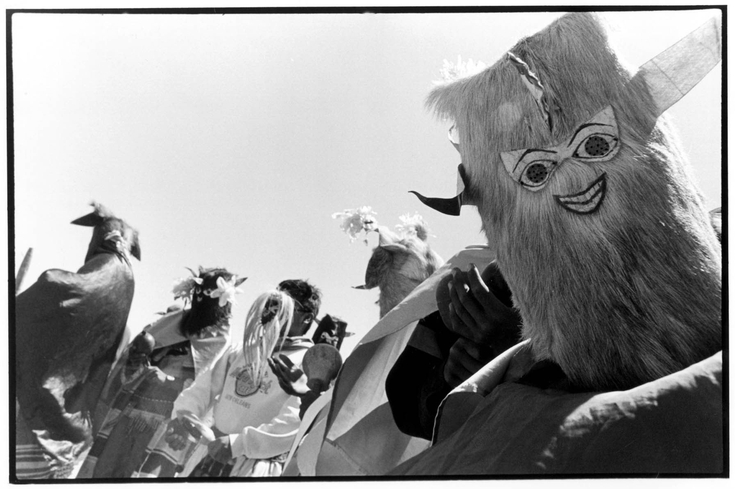
|
|
Rancho Camargo, Sonora 3/29/02 Fariseos. |
WORKPLACE | STRIKES | PORTRAITS | FARMWORKERS | UNIONS | STUDENTS
Special Project: TRANSNATIONAL WORKING COMMUNITIES
HOME | NEWS | STORIES | PHOTOGRAPHS | LINKS
photographs and stories by David Bacon © 1990-
website by DigIt Designs © 1999-